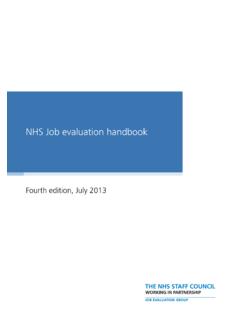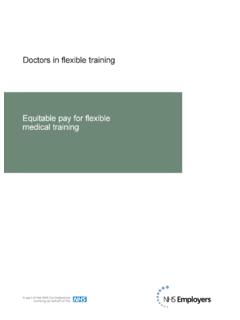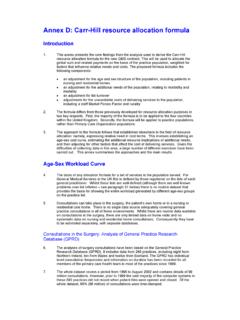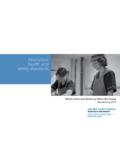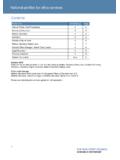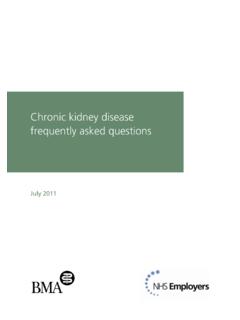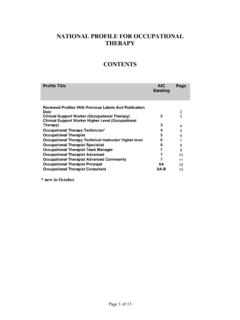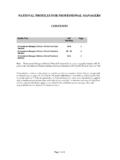Transcription of web blue book - chapter 44 FORMATTED 2
1 stress management Introduction Work-induced stress is now widely recognised as a significant problem in the health service as well as in all other sectors of the economy. The Health and Safety Executive (HSE) says that workers in health and social care have some of the highest rates of self-reported illness due to stress , anxiety and depression1. Across all sectors, around a third of new incidences of ill health at work are due to work-related stress . An average of 31 working days is lost for each case of stress several times the average time taken off for sickness per employee per year. Across all employers the HSE reports that stress , anxiety and depression are estimated to account for self-reported working days lost each year. This is not a problem the NHS can ignore. There are enormous costs to the NHS of work-related stress : around 30 per cent of sickness absence in the NHS is due to stress , with a bill to the service of 300- 400m per year2. However, stress can also contribute to accidents and errors by employees, low morale and poor performance.
2 It has a significant impact on the well-being of staff, their productivity and effectiveness. The 2008 staff survey shows there is a marked reduction in the proportion of staff (28 per cent) who said they had suffered from work-related stress in the last year compared to 2007 (33 per cent) and 2006 (33 per cent) While this percentage varied little between acute and foundation trusts, some individual mental health and ambulance trusts had high levels of reported stress above 40 per cent of staff in some cases. There were also significant variations between different staff groups. Midwives in acute trusts, district and community nurses in mental health trusts and also some ambulance trust staff generally reported high levels of stress . Disabled staff also reported high stress levels at over 49 per cent. Much work-related stress is likely to be preventable and NHS organisations have legal obligations to prevent or reduce stress . This should ensure that organisations put a high priority on identifying, reducing and preventing work-associated stress .
3 In 2001 the HSE issued new guidance, Tackling work-related stress : a manager s guide to improving and maintaining employee health and well-being. This encourages a pro-active approach and highlights the major role managers can play in reducing the problems of stress . The HSE issued management standards of good practice in 2007 and these were amended in 2008. They help employers to measure their performance in tackling a range of key stressors. One NHS trust has already been issued with a 1 Self-reported work-related illness and workplace injuries in 2005/06 : Results from the Labour Force Survey, HSE 2 See compliance notice for failing to have a policy in place and not carrying out any assessment of the risks to staff of work-related stress . This section should be read in conjunction with the NHS Employers stress website, What is stress ? The HSE defines stress as people s natural reaction to excessive pressure.
4 It is not a disease. But if stress is excessive and goes on for some time, it can lead to mental and physical ill health (for example depression, nervous breakdown, heart disease). Work-related stress might also be defined as a pattern of emotional, cognitive, behavioural and physiological reactions to adverse and noxious aspects of work content, work organisation and work environment. It is characterised by high levels of arousal and distress, and often by feelings of not coping. stress is not an illness in itself and it should not be seen as an indicator of psychological problems or an inability to do a job properly. However, if left unaddressed, it can lead to physical and mental ill health. The HSE factsheet, Myths and facts, adds the following points: work-related stress is not good for people. Ill health because of work-related stress is now one of the most common types of workplace health problems work-related stress is something anyone can suffer from and is not something that only happens to wimps research has shown that support at work, particularly from managers for their staff, has a protective effect and that frontline prevention by the organisation is better than third-party cures there is a lot that employers can do to prevent work-related stress .
5 As a first step, they can consult with their staff or trade unions to identify problems and work towards agreed solutions. There are two other definitions of stress which add to or support the HSE definition. The Confederation of British Industry defines it as that which arises when the pressures placed upon an individual exceed the perceived capacity of that individual to cope. The Trades Union Congress says that stress occurs where demands made of individuals do not match the resources available or meet the individual s needs and motivation. stress will be the result if the workload is too large for the potential number of workers and time available. Equally, a boring or repetitive task which does not use the potential skills and experience of some individuals will cause them stress . The causes of stress stress is caused by a poor match between the worker and the work, by conflicts between roles at work and outside it, and by not having a reasonable degree of control over work and life balance.
6 stress at work can be caused by a multitude of stressors. In Tackling work-related stress : a manager s guide to improving and maintaining employee health and well-being, the HSE identified seven broad categories of risk factors for work-related stress . Culture issues, which could include lack of positive response to stress or health concerns, lack of staff involvement, poor communication, lack of consultation and participation in decision making, and long work hours or lack of rest breaks. Demands such as lack of challenge and pressure, exposure to violence or aggression, work overload, poor physical environment, lack of training, lone working, and fast pace of work. Control issues which as a low level or lack of control over task design, or non-participation in decision making. Relationships with those working with them or patients. This can range from bullying and harassment, through lack of support for the employee to physical violence.
7 Change many people in the NHS would recognise change as a stress factor over the last few years. This could include changing market demands, new technology, and organisational restructuring. The individual s role, and conflicts and ambiguity within it. Support, training and individual factors such as lack of adequate training, mismatch between person and job, lack of support or feedback, and lack of constructive advice. Is stress dangerous? The answer is yes and no. stress is potentially disease-provoking when: occupational demands are high and the worker s influence over his or her conditions of work is low there is insufficient social support from management and fellow workers the reward offered to the worker in terms of remuneration, esteem or status does not match the effort invested. The potential for provoking disease is increased when the conditions referred to above are intensive, chronic and/or often repeated. Common end-results include a wide range of physical and mental morbidity.
8 The answer is more likely to be no if workers are: allowed within reasonable limits to manage their own workload encouraged to take control over their own work conditions offered adequate social support given reasonable rewards for efforts invested. When people feel in control, stress becomes a challenge rather than a threat the good stress that is often referred to. The following are examples of the more common effects associated with work-related stress , for organisations and for individual workers: For organisations: rising levels of absenteeism increased staff turnover increased recruitment costs poor public image low staff commitment under-performance low staff morale low productivity increased accidents and mistakes poor relationships with clients possible compensation claims. For individuals: high levels of anxiety low self-esteem and low self-confidence inability to concentrate difficulty in thinking rationally being prone to accidents headaches or migraine depression panic attacks demotivation chest pains stomach problems relationship problems.
9 Research has indicated that constant exposure to work-related stress may result in either mental or physical illness. In the most serious cases, illnesses that have been linked to work-related stress include cancer, ulcers, asthma, diabetes, alcoholism and nervous breakdowns3. The legal position The Health and Safety at Work etc Act 1974 states that every employer should ensure, so far as is reasonably practicable, the health, safety and welfare at work of all of their employees . The management of Health and Safety at Work Regulations 1992 require employers to adopt modern risk management techniques such as: identify any hazards and assess all the risks to the health and safety of employees, and record the findings of the assessment. stress should be considered along with other work hazards review and modify risk assessments at regular intervals and also when there are developments or changes in the work or if adverse events have taken place provide health surveillance where the risk assessment shows that adverse health conditions have occurred or are likely to occur under the particular conditions of work.
10 This may aid early detection of stress apply the following principles or hierarchy to preventative and protective measures: 1. avoid the risk altogether 2. combat risks at source 3. wherever possible, adapt work to the individual 4. implement improved working methods and technological changes, where these can make work safer 5. incorporate risk prevention strategies as part of a coherent policy 6. give priority to those measures that protect the whole workplace. The HSE has been working with the NHS to roll out management standards of good practice which employers can use to measure their performance when tackling a range of issues that can lead to stress . Trusts which undertake the appropriate policies and interventions to manage workplace stress can reduce the risk of legal intervention. However, trusts are also at risk of civil action from employees who have suffered from stress . Showing that they apply policies and procedures to identify and lessen work-related stress among employees is likely to be useful in defending such actions.
